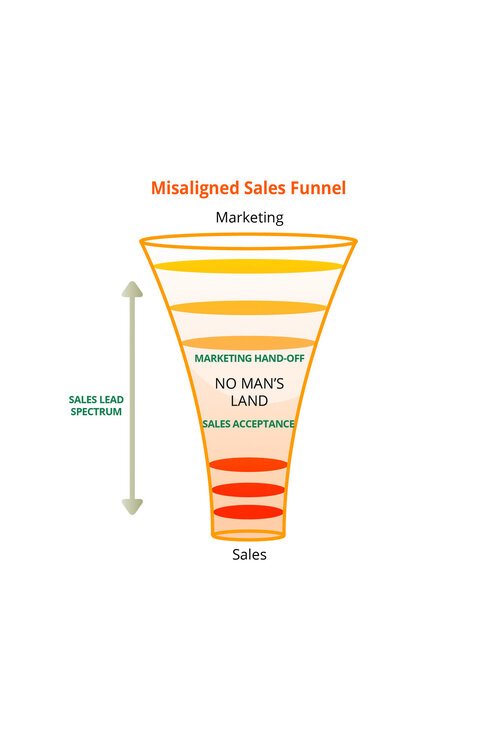How to achieve Sales > Marketing > Customer Alignment in 3 Steps
An article by the Wharton School talks about how the world of marketing has changed and how the CMO's role is being fundamentally redefined.
According to the article, “the concrete silos within organizations need to become thin walled stove pipes connected at multiple levels. At present, different functions like sales, marketing, delivery, customer support and quality typically work in silos and own different facets of the customer life cycle. But delivering the next generation user experience requires a collaborative enterprize.”
Our own research shows a vast gulf separating financially successful organizations from the less successful ones that correlates to the way they approach Sales+Marketing Collaboration. In other words, we were able to demonstrate a direct correlation between close Sales+Marketing Collaboration and financial business success. The closer the collaboration, the greater the success.
A staggering 81.5% of companies that reported a decrease in sales revenue in the previous year operate across separate Sales and Marketing silos.
Furthermore, growth organizations are, by and large, those that hold vastly more formal meetings between their sales and marketing
teams than non-growth organizations, with an astounding average of 24% of the less successful ones admitting that they meet either “never” or only “annually” (presumably at the start-of-year sales kick-off). Perhaps unsurprisingly, more than 65% of large companies in which sales and marketing departments reportedly meet either “never” or “annually” reported decreasing revenue.
Organizations that said they had been unable to grow their revenue over the previous 12 months also seemed to have a sizable gap between their sales and marketing teams in terms of what they thought was most important to growing sales results.
Marketing teams in less successful companies overwhelmingly reported that nurturing leads for Sales was their top priority. In more successful organizations, it was promotional activities and lead generation that marketing teams tended to select as their top priorities.
The story was similar when we turned our focus to sales teams in successful organizations: there tended to be more substantial overlap between Sales and Marketing. Far more frequently than they did so in less successful companies, the sales teams in the better performers in the study reported that the qualifying of sales leads was an important objective for the sales department.
This source of this perception gap is relatively obvious once you start to look at collaborative trends and how they relate to success. Less successful organizations are often those with separate performance metrics in each department. In other words, less successful organizations do not support objective alignment between the sales and marketing functions through joint metrics and KPIs. Since they are such an obvious place of overlap and often a source of friction between Sales and Marketing, sales leads are a great place to start the Sales/Marketing alignment process.
Just last year, Accenture found that more than 50% of the leads
that Sales pursues are self-generated, with the remaining half split between customer referrals and leads that are generated by Marketing. Incidentally, this isn’t due to a lack of marketing-originated leads being fed into the pipeline or the funnel – quite the contrary. The issue is not with quantity – it’s with quality.
According to a joint study conducted by Vorsight and the Bridge Group, sales departments that were surveyed felt that almost 70% of the sales leads that Marketing fed into the sales pipeline were sub-par. 70% of their prospects were neither positioned, nor inclined to purchase at the time of contact. In other words, from a salesperson’s perspective, more than two thirds of the leads that are being fed into the pipeline or funnel are practically useless. More than half of reps surveyed reported that less than 25% of marketing-generated leads were in their so-called “sweet spot”.
One way to make broader consensus possible is to institute solid lead scoring practices. Only 40% of the companies that participated in the Vorsight/Bridge Group study were using lead scoring, so it is quite possible that the absence of practical tools that can help Marketing fully qualify leads in a way that Sales understands and appreciates may be at the root of the issues surrounding lead generation and acceptance.
In order to put a lead-scoring system in place, though, we need to bridge a sizable definition gap first. The evidence that this gap exists (and is causing problems) is everywhere. I have seen marketing teams that consider someone’s business card a lead (clearly setting the bar too low). On the other hand, I have heard salespeople say, “I only want sales leads when the customer is purchase-ready now!” (clearly, this is setting the bar too high).
In reality, of course, the bar needs to be set somewhere between these too extremes, neither too high, nor too low – in the sales lead ‘Goldilocks Zone’ if you will.
Technology vendors have been quick to don the cape and tights, claiming they have the solution to all of the issues surrounding definitions and lead scoring. They have created a defined series of process steps that are shared by Sales and Marketing which aim to eliminate the ‘No-Man’s Land’ in the middle of the funnel, which is illustrated below.
According to this school of thought, Marketing first generates and then nurtures the sales leads up to a mutually agreed-upon point in the pipeline. Once that point has been reached, Marketing hands the lead over to Sales for follow up. This gives us two new sets of definitions: Marketing-Qualified Leads (MQLs) and Sales-Accepted Leads (SALs). While this approach is a good start, it is not the complete solution that some are claiming it to be. Sales and Marketing are retreating into their respective definitions and using them to deflect responsibility. What’s worse, it seems that they’re still not speaking the same language: MQLs seem to be largely focused on relationship quality and revenue potential, whereas SALs often focus purely on revenue conversion. Clearly, alignment along process lines does not automatically produce collaboration between Sales and Marketing. Something extremely important has been left out of the equation.
The latest data from CSO Insights suggests that, while there has been improvement in the last few years, more than 50% of organizations still lack a formal definition as to what constitutes a ‘qualified lead’. As might be expected, having a formal and agree-upon definition in place strongly correlates to higher conversion rates. Those with a formal definition in place had conversion rates some 50% higher than those without any kind of concrete definition.
This is a solvable issue, yet we find that many organizations seem poorly equipped to address this misaligned sales funnel without outside help. Before even attempting to bring Sales and Marketing together, many of the more successful organizations begin by adjusting their sales force KPIs so as to bring their sales departments into lockstep with their marketing teams. Aberdeen Group reports that 72% of best-in-class companies have a team-oriented approach toward sales performance management. This number drops to less than 50% among those at or below the average in terms of performance. Tying compensation to team performance assures that those who are finding success are making sure to share their strategies with their colleagues.
This does not, however, completely lift the crucial burden of personal sales quotas, which, as Jason Robinson of Digital Bridge recently pointed out, remain the primary concern for salespeople (not, as many marketers seem to think, conversion rates). Personal sales quotas remain a significant factor in Sales performance, so it would be unwise to make KPIs broadly collective. Again as per Aberdeen, the best-in-class performers are those that can strike the finest balance between team and individual performance through collective goal setting and constructive Sales Manager/sales rep relationships.
If Sales and Marketing Collaboration is the eventual goal (and it should be), the lone-wolf attitude that is so typical of some salespeople (as well as the collective ‘go-it-on-our-own’ attitude prevalent in sales departments) needs to make way in favor of a more cooperative mindset. As mentioned, we discovered that alignment along single process lines does not automatically result in good collaboration. For collaboration to be effective it needs to be guided by soft skills and with a human touch, it can not be demanded.
To summarize, collaboration is best not left to middle management. It requires C-level executive support and engagement because it is of strategic importance to the entire organization.
However, once you have that senior level engagement you can reach Sales & Marketing collaboration in three steps:
1. Benchmark the true level of collaboration between Sales and Marketing teams to draw a line in the sand to move forward from. Benchmarking is necessary in order to determine just how bad or good the Sales & Marketing relationship at every level is today, where the bottlenecks are, and where the 'low hanging fruit' opportunities lie.
Importantly, also consult your customers all along the buyers journey on their perception of your Sales and Marketing efforts. This is best done by an external and independent, neutral 3rd party so that it is not influenced by existing relationships and in order to solicit true, frank and honest feedback from all stakeholders.
2. Coach the parties' and their players on all levels (i.e. not just your executive team) on why closer collaboration is good for them.
Then help them to define and agree on the collaboration processes and metrics that they will from now on live by. Answer questions such as "What's in it for me?" and "What does success look like for me, for my department and for the whole organization?" Make sure that there is universal agreement on the above.
3. Implement and support the collaboration processes with the appropriate collaboration technology. Don't be tempted to rush this step. It is important to leave this until the parties have agreed on why and how they will work together because a technology-lead approach will only encounter the usual resistance as people often reject change that is imposed on them (just look at how unsuccessful many CRM implementations are around the world).
Provide ongoing coaching, either by a neutral collaboration services provider or by a dedicated internally appointed and empowered 'collaboration czar', so that collaboration can grow beyond the walls of head office, and so that it can remain sustainable for a long time, even when internal personnel and external circumstances change.
Thank you for reading this post
If you enjoyed this post then please ‘like' it and share it via Twitter and your other social media forums. Please also feel free to add your own comments or to ask a question about this post, I will do my best to answer them.
If you are interested in seeing what about other articles that I have written then please visit my LinkedIn Publishing page for more of my postings.
Join Us
If the subject of Sales and Marketing alignment and collaboration is of interest to you then please join my LinkedIn group, the Sales+Marketing Collaboration Community.
About the Author
Peter Strohkorb is a Consultant, a published Author, an international Speaker and Executive Mentor as well as an Executive MBA guest Lecturer on Sales and Marketing collaboration and alignment.





